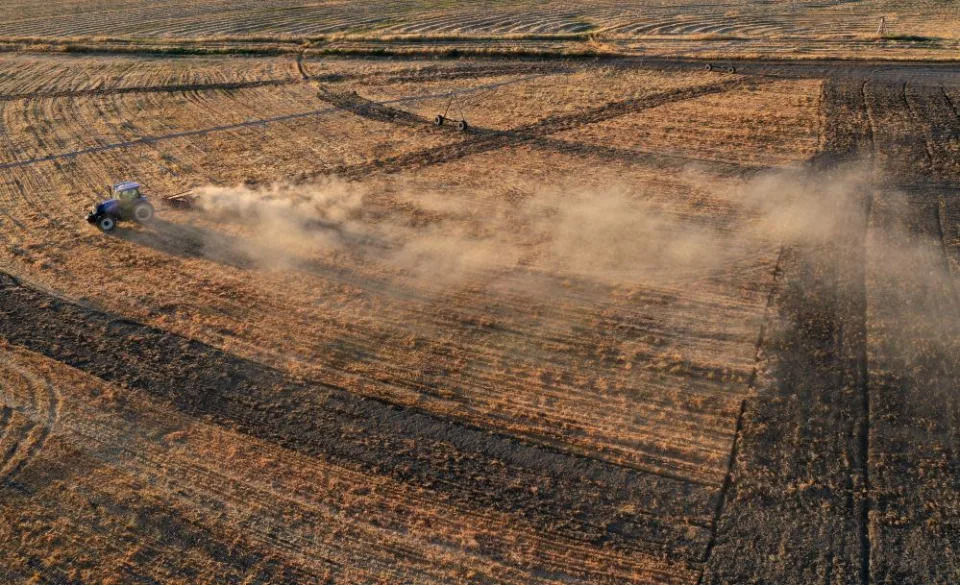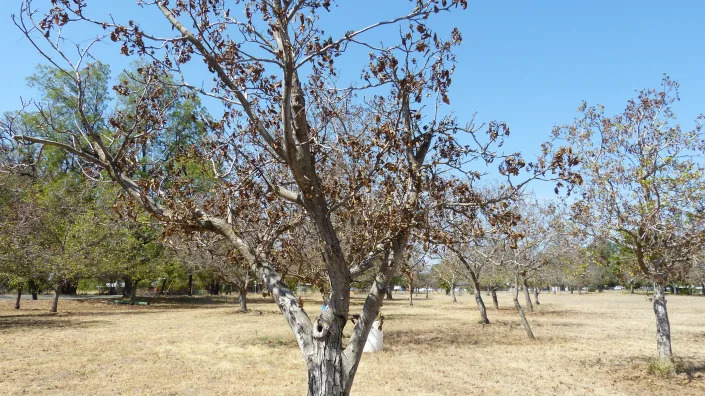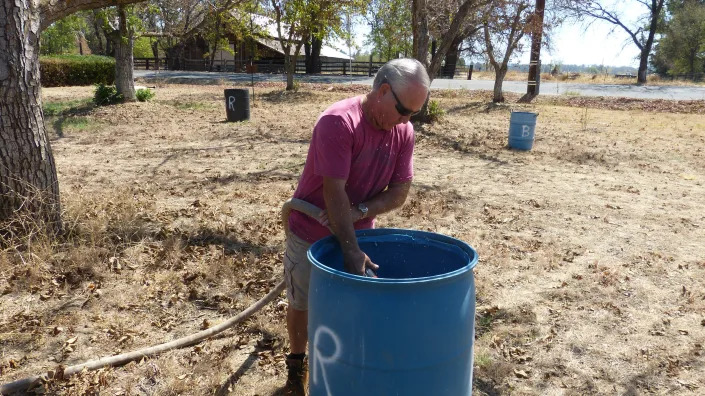Time
Where We’ll End Up Living as the Planet Burns

A firefighter helicopter drops water to put out a wildfire in the Baixa Limia – Serra do Xures Natural Park near the village of Lobeira, Ourense province, northwestern Spain, on August 25, 2022. Credit – MIGUEL RIOPA- AFP/Getty Images)
While nations rally to reduce their carbon emissions, and try to adapt at-risk places to hotter conditions, there is an elephant in the room: for large portions of the world, local conditions are becoming too extreme and there is no way to adapt. People will have to move to survive.
Over the next fifty years, hotter temperatures combined with more intense humidity are set to make large swathes of the globe lethal to live in. Fleeing the tropics, the coasts, and formerly arable lands, huge populations will need to seek new homes; you will be among them, or you will be receiving them. This migration has already begun—we have all seen the streams of people fleeing drought-hit areas in Latin America, Africa, and Asia where farming and other rural livelihoods have become impossible.
The number of migrants has doubled globally over the past decade, and the issue of what to do about rapidly increasing populations of displaced people will only become greater and more urgent as the planet heats.
We can—and we must—prepare. Developing a radical plan for humanity to survive a far hotter world includes building vast new cities in the more tolerable far north while abandoning huge areas of the unendurable tropics. It involves adapting our food, energy, and infrastructure to a changed environment and demography as billions of people are displaced and seek new homes.
Our best hope lies in cooperating as never before: decoupling the political map from geography. However unrealistic it sounds, we need to look at the world afresh and develop new plans based on geology, geography, and ecology. In other words, identify where the freshwater resources are, where the safe temperatures are, where gets the most solar or wind energy, and then plan population, food and energy production around that. The good news is, there’s plenty of room on Earth. If we allow 20 square meters of space per person—around double the minimum habitable size for a house allowed under the International Residential Code—11 billion people would need 220,000 square kilometers of land to live on. There would be plenty of room to house everyone on earth in a single country—the surface area of Canada alone is 9.9 million square kilometers. Of course, I’m not proposing anything as absurd, but this is something to reflect on when it is claimed that a country is “too full” for more people.
The bad news is that no place on Earth will be unaffected by climate change. Everywhere will undergo some kind of transformation in response to changes in the climate, whether through direct impacts or the indirect result of being part of a globally interconnected biophysical and socioeconomic system. Extreme events are already occurring around the world and will continue to hit “safe” places. Some places, though, will be more easily adaptable to these changes, while others will become entirely uninhabitable fairly quickly. Bear in mind that many places will be uncomfortable if not intolerable by 2050—around the lifespan of most mortgages—we need to start planning where we make our homes now. By 2100 it will be a different planet, so let’s focus on some of the livable options.
Global heating is shifting the geographical position of our species’ temperature niche northwards, and people will follow. The optimum climate for human productivity—the best conditions for both agricultural and nonagricultural output—turns out to be an average temperature of 11°C to 15°C, according to a 2020 study. This global niche is where human populations have concentrated for millennia, including for the entirety of human civilization, so it’s unsurprising that our crops, livestock and other economic practices are ideally adapted to these conditions. The researchers show that, depending on scenarios of population growth and warming, ‘1 to 3 billion people are projected to be left outside the climate conditions that have served humanity well over the past 6,000 years.’ They add that, ‘in the absence of migration, one third of the global population is projected to experience mean average temperatures [that are currently found mostly] in the Sahara.’
As a general rule, people will need to move away from the equator, and from coastlines, small islands (which will shrink in size), and arid or desert regions. Rainforests and woodlands are also places to avoid, due to fire risk. Populations are going to shift inland, towards lakes, higher elevations and northern latitudes.
Looking at the globe, it is immediately clear that land is mainly distributed in the north—less than a third of Earth’s land is in the southern hemisphere and most of that is either in the tropics or Antarctica. So the scope for climate migrants to seek refuge in the south is limited. Patagonia is the main option, although it is already suffering from droughts, but agriculture and settlement there will remain possible as the global temperature rises. The main lands of opportunity for migrants, however, are in the north. Temperatures in these safer regions will rise—and will rise faster in higher latitudes than at the equator – but the average absolute temperature will still be far lower than in the tropics. Of course climate disruption brings extreme weather, and nowhere will be spared these increasingly common events—Canada reached temperatures of 50°C in 2021, making British Columbia hotter than the Sahara Desert, and then, a few months later, was hit by deadly floods and landslides that displaced thousands. Fires have blazed across Siberia’s tundra, and melting permafrost is a shifting, unstable ground on which to build infrastructure.
Happily, however, the northern latitudes are already home to wealthier nations that generally have strong institutions and stable governments that are among the best placed to build social and technological resilience to the challenges this century.
Problematically, many of them have also struggled politically with immigration to a far greater extent than have many much poorer countries (poor countries also host by far the greatest numbers of displaced people), and with a migrant “crisis” that is far smaller than the great climate migration we will see over the next 75 years. It may be more possible to shift a political-social mindset in the space of a few years, however, than to return the tropics to habitability. Consider that most of Europe’s nations each rely on tens of thousands of migrant workers just to harvest the crops they grow today. With better agricultural conditions across the north, the need for labour will only increase.
North of the 45°N parallel—which runs through Michigan in North America, France, Croatia, Mongolia, and Xinjiang in China, for instance—will be the twenty-first century’s booming haven: it represents 15 per cent of the planet’s area but holds 29 per cent of its ice free land, and is currently home to a small fraction of the world’s (aging) people. It’s also entering that optimum climate for human productivity with mean average temperatures of around 13°C.
Inland lake systems, like the Great Lakes region of Canada and the U.S., will see a huge influx of migrants—reversing the previous exodus from these areas—as the vast bodies of water should keep the region fairly temperate. Duluth in Minnesota on Lake Superior bills itself as the most climate-proof city in the U.S., although it’s already dealing with fluctuating water levels. Other upper Midwest cities around the lakes, including Minneapolis and Madison, are also likely to be desirable destinations. More southerly Midwestern cities face the threat of extreme heatwaves. The University of Notre Dame’s Global Adaptation Initiative researchers concluded that “eight of the top 10 cities facing the highest likelihood of extreme heat in 2040 are located in the Midwest,” including cities from Detroit to Grand Rapids. Further east, locations get riskier quickly, but Buffalo in New York State, and Toronto and Ottawa in Canada look to be safer choices for migrants from the coasts.

Preparation and adaptation could enable some cities to survive on a coastal location. Boston, for instance, is far enough north to escape much of the projected extreme heat, and planners have developed a detailed strategy that includes elevating roads, building up coastal defences, and introducing marshes to absorb flood waters. New York City, which faces extreme threats but might be too important to fail, is similarly planning extensive defences, although it’s unclear how effective these will prove. Its planned Big U, a vast sea wall to protect the financial district of lower Manhattan would leave anyone living north of West 57th Street exposed to the waves. The city is already dealing with regular inundations, which in 2021 killed dozens, and saw people swimming in flooded subway stations and geysers erupting out of the streets’ drainage covers. (Many of the people who died when Hurricane Ida hit New York City in 2021 were poorer residents living in basement apartments that flooded.) Coastal cities that are far enough north and have steep enough coasts to protect against storm surges as sea levels rise will be safer.
Much of the rest of the U.S. will be problematic for one reason or another. The central corridor will see worsening tornadoes; below the 42nd parallel, heatwaves, wild fires and drought will be perilous; at the coasts, flooding, erosion and freshwater fouling will be an issue. Today’s desirable locations, such as Florida, California and Hawaii, will be increasingly deserted for the more pleasant climates of former Rustbelt cities that will experience a renaissance, as a globally diverse community of new immigrants revitalizes them.
Read More: If You Want to Know a Country’s Economic Future, Check How Far From the Equator It Is
Alaska looks the best place to live in the U.S., though, and cities will need to be built to accommodate millions of migrants heading for the newly busy Anthropocene Arctic. In 2017, the U.S. Environmental Protection Agency released a Climate Resilience Screening Index, which ranked Kodiak Island, Alaska, as being at the lowest risk of climate events in the country. By 2047, Alaska could be experiencing average monthly temperatures similar to Florida today, according to an analysis of climate models. As with everywhere, location is key, though—the residents of Newtok, Alaska, are relocating because melting permafrost and increasing erosion have caused portions of their village to wash away. The retreat of ice sheets and melting of tundras is already causing huge problems for indigenous communities, whose way of life is being irrevocably altered. Their terrible loss, and that faced by native wildlife—not to mention other dangers, including unknown pathogens lurking in the currently frozen tundras, waiting to be exposed—will be countered by the vast opportunities for development in the New North. This is where many of the tropical migrants will create new homes during the turbulent twenty-first century, while humanity battles to restore a liveable globe. Whether self-governed indigenous communities will welcome this influx of southern migrants or reject what is the latest in a long history of often-violent intrusions remains to be seen. However, people will move north and they will need to be accommodated.
The New North
With agriculture newly possible and a bustling North Sea Passage shipping route, the far north will be transformed. The melting of Greenland’s ice sheet—the largest on Earth after Antarctica—will expose new areas for people to live, farm and mine minerals. Buried beneath the Arctic ice of Greenland, Russia, the U.S. and Canada, there is also useful agricultural soil and land to build cities upon, giving rise to a hub of connected Arctic cities.
Nuuk is one such city set to grow rapidly over the coming decades. The capital of Greenland (an autonomous outpost of Denmark) sits just below the Arctic Circle, where the effects of climate change are obvious—residents already talk of the years ‘back when it was cold’. Fisheries here are experiencing a boost: less ice means boats can fish close to shore year round, while warmer ocean temperatures have drawn new fish species further north into Greenland’s waters. Some halibut and cod have even increased in size, adding commercial value to fish catches. Land exposed by the retreating ice is opening up new farming opportunities with a longer growing season and plentiful irrigation. Nuuk’s farmers are now harvesting new crops, including potatoes, radishes, and broccoli. The retreating ice is also exposing mining opportunities and offshore exploration, including for oil. Nuuk stands at the edge of real economic gain. The country already has five hydroelectric plants to turn its abundant meltwater into power. According to projections Greenland will even have forests by 2100. It may be among the best places to live.

Similarly, Canada, Siberia and other parts of Russia, Iceland, the Nordic nations and Scotland will all continue to see benefits from global heating. Arctic net primary productivity, which is the amount of vegetation that grows each year, will nearly double by the 2080s, with an end to cripplingly cold winters. Growing seasons will significantly expand, particularly around today’s farmland. The Nordic nations already enjoy relatively warm temperatures because of the North Atlantic currents, but continental temperatures, which can plunge below –40°C in winter, will also ease, making interior locations more bearable. Nordic nations score comparatively low on climate change vulnerability and high on adaptive readiness.
Global heating has already boosted Sweden’s per capita GDP by 25 per cent, a Stanford study found. The biggest greenhouse gas emitters “enjoy on average about 10 per cent higher per capita GDP today than they would have in a world without warming, while the lowest emitters have been dragged down by about 25 per cent,” the researchers found. The moral argument for including tropical migrants in the economies of the north is clear. The researchers estimate that India’s GDP per capita has lagged by 31 per cent owing to global heating; Nigeria’s has lagged by 29 per cent; Indonesia’s by 27 per cent; and Brazil’s by 25 per cent. Together, those four countries hold about a quarter of the world’s population.
Rapid ice melt will make the Northwest Passage—the sea route through the Arctic connecting the Atlantic and Pacific Oceans—open and navigable for shipping for much of the year, cutting shipping times by around 40 per cent. This will enable easier regional trade, tourism, fishing and travel, as well as open opportunities for mineral exploration. Port cities, such as Churchill in Manitoba, Canada, will profit. This barren outpost, wedged between boreal forest, Arctic tundra and Hudson Bay, has just 1,100 residents, who rely almost entirely on polarbear tourism. Churchill’s land was considered so undesirable that in 1990 the US freight company OmniTrax bought the town’s port from the Canadian government for $7. However, with an active migration programme recruiting people and businesses from around the world, the newly developed city could support international trade through its revitalized port on the Hudson Bay—the only commercial deepwater port in northern Canada. This could make it a key stopping and unloading point on the Northwest Passage for cargo ships coming all the way from Shanghai. Churchill is connected to Winnipeg and the rest of Canada—and the U.S.—via its restored railway line. And it’s just over 100 kilometres from Nunavet, Canada’s newest indigenous province, a growing Inuitgoverned territory.
Read More: What Extreme Heat Does to the Human Body
Churchill could become a booming city. Indeed, Canada will be a key destination for our migrants, and the government is betting on it, aiming to triple the population by 2100 through immigration. Marshall Burke, Deputy Director of the Center on Food Security and the Environment at Stanford University, calculated that global heating could raise the average income in Canada by 250 per cent due to greatly expanded growing seasons, reduced infrastructure costs and increased maritime shipping.15 With a stable, noncorrupt democracy, onefifth of the world’s freshwater reserves and as much as 4.2 million square kilometres of newly arable farmland, Canada could be the world’s new breadbasket later this century.
Russia will be another net winner—its 2020 national action plan explicitly describes ways to “use the advantages” of climate warming. According to the U.S. National Intelligence Council, Russia “has the potential to gain the most from increasingly temperate weather.” The country is already the world’s biggest exporter of wheat, and its agricultural dominance is set to grow as its climate improves. By 2080, more than half of Siberia’s permafrost will have gone, making the frozen north more attractive, with longer growing seasons, and able to support much larger populations, according to models. Though there is much potential gain, the loss of permafrost and of ice roads will be hugely problematic for the climate and also for many settlements that depend on frozen foundations for buildings, roads, railway tracks and other infrastructure. Engineering techniques exist to deal with the problem, but they are very expensive.
Other places that will see new or expanded cities include Scotland, Ireland, Estonia, and elevated sites with plenty of water, like Carcassonne in France, which is surrounded by rivers. In the global south, as mentioned, there is far less landmass in the high latitudes, but Patagonia, Tasmania and New Zealand, and perhaps the newly icefree parts of the western Antarctic coast, offer potential for cities. In Antarctica alone, up to 17,000 square kilometres of new, icefree land is projected to appear by the end of the century. This could offer an opportunity for development, but I fervently hope that Earth’s last wild continent will remain a precious nature reserve.
Elsewhere, people will move to higher elevations, including the Rocky Mountains in North America and the Alps in Europe. In the US, Boulder and Denver, both above 1,600 metres, are already attracting migrants, and Ljubljana in Slovenia is another alpine location with a rich underground aquifer system and lush agriculture.
People will aim for safer places, and they will be better off moving to locations that already have good governance, productivity and resources. Happily, there are many places where these coincide. Some of this migration will involve rapidly expanding existing towns and cities; in other places, such as Russian Siberia and Greenland, entirely new cities will need to be built.
Achieving safe settlement for hundreds of millions of migrants could require the compulsory purchase by international consensus of land held by current states, with compensation and a stake in the new cities and their industries. It could require a new kind of international citizenship. It could mean richer, safer latitude states becoming ‘care taker states’ for poorer, more vulnerable ones, during the crisis period of global heating until planetary restoration. It could involve charter cities, states within states, the extinction of some of the 200 nation states and consolidation of the remaining few into regional geopolitical entities. There are many alternative visions to today’s status quo of nation states, borders and passports – which are, after all, relatively recent.
Instituting global freedom of movement, for instance, would boost national economies, as well as saving or improving billions of lives. Open borders would, it’s fair to assume, result in very large flows of people—estimations range from a few million to more than 1 billion—and it could increase global GDP by tens of trillions of dollars. Among the catastrophic losses this century, we have so much potential to gain if we open our minds to different ways of living, unsticking people from their fixed abodes. People will move in their millions this century, and right now we have a chance to make this upheaval work through a planned, managed peaceful transition to a safer, fairer world. We must try.
Adapted from Vincent’s new book NOMAD CENTURY: How Climate Migration Will Reshape Our World, published by Flatiron Books














